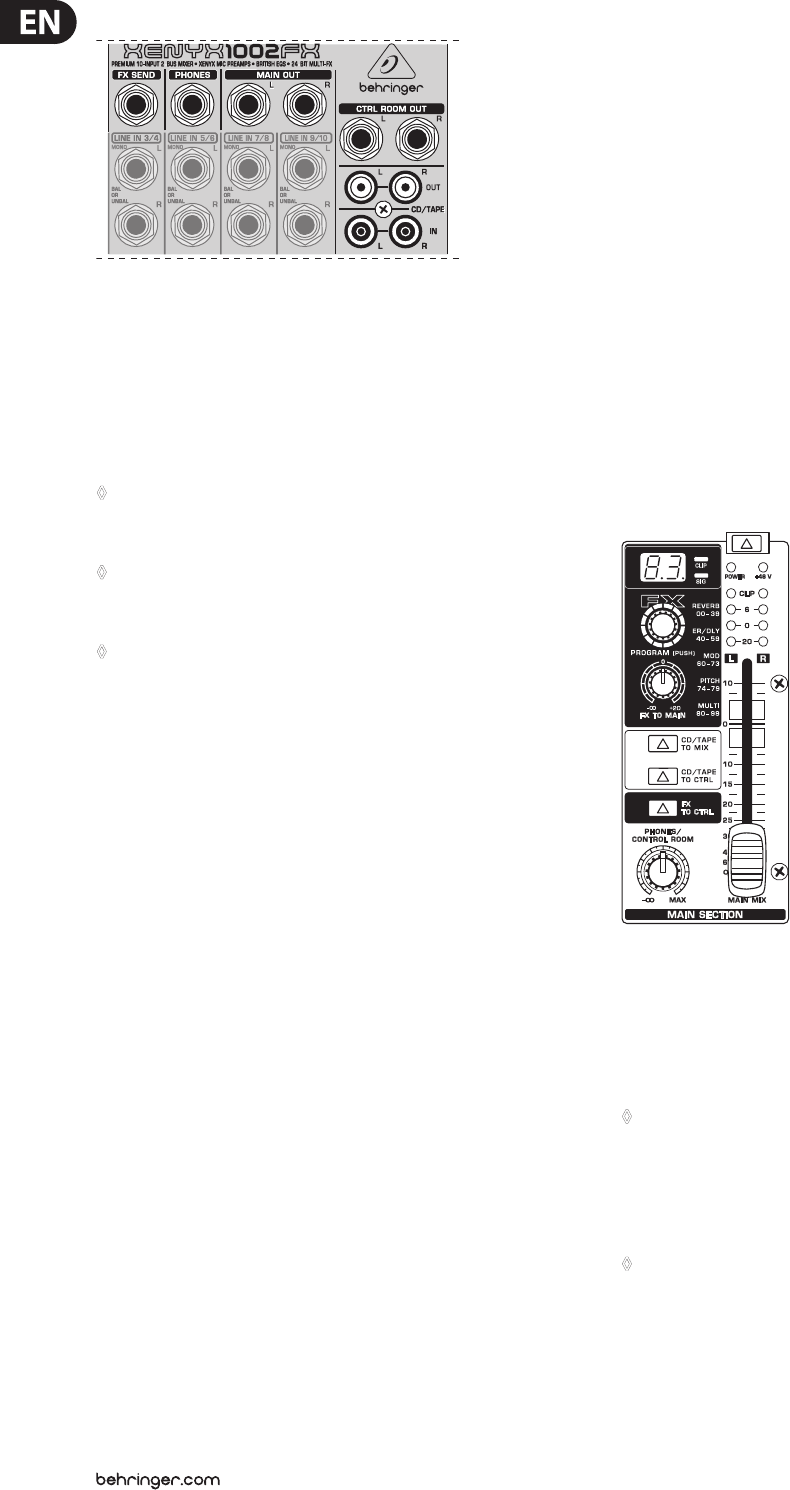
8 XENYX 1202FX/1002FX User Manual
2.3 Connector array of the main section
Fig. 2.3: Connectors of the main section
FX SEND
The FX SEND connector outputs the signal you picked up from the individual
channels using the FX controls. You can connect this to the input of an external
eects device in order to process the FX bus’ master signal. Once an eects mix is
created, the processed signal can then be routed from the eects device outputs
back into a stereo input.
◊ If the connected effects processor receives no input signal,
the FX SEND control is probably too low. This also goes for the built-in
effects processor.
◊ Adjust your external effects processor to 100% wet (effects signal
only), because the effects signal is added to the main mix along with
the “dry” channel signals.
◊ In this instance, the FX control of the channel being used as an effects
return should be turned fully counterclockwise, otherwise feedback
problems can occur!
PHONES/CTRL ROOM OUT
The stereo PHONES connector (at the top of the connector panel) is where
headphones are connected. The unbalanced CTRL ROOM OUT connectors carry
the summed eects and main mix signals as well as soloed channel signals.
ThePHONES/CONTROL ROOM control in the main section adjusts the level of both
headphones and main monitor outputs.
MAIN OUT
The MAIN OUT connectors are unbalanced mono connectors. The main mix
signal appears here at a level of 0 dBu. The MAIN MIX fader adjusts the volume of
these outputs. Depending on how you wish to use your mixer and which gear you
own, you can connect the following equipment:
Live PA systems:
A stereo dynamics processor (optional), stereo equalizer (optional) and the stereo
power amplier for full-range loudspeakers with passive crossovers.
If you wish to use multi-way loudspeaker systems without an integrated
crossover, you have to use an active crossover and several power ampliers.
Often, limiters are already built into active crossovers (e.g. BEHRINGER
SUPER-XPRO CX2310 and ULTRADRIVE PRO DCX2496). Active crossovers are
implemented directly before the power amplier, and they divide the frequency
range into several segments that are rst amplied in the ampliers and then
passed on to the corresponding loudspeakers.
Recording:
For mastering, using a stereo compressor such as the COMPOSER PRO-XL
MDX2600 can be recommended. Use it to custom-tailor the dynamic
characteristics of your signal to the dynamic range of the recording equipment
you are using. The signal is in this case passed on from the compressor into
therecorder.
CD/TAPE INPUT
The CD/TAPE INPUTs are used to bring an external signal source (e.g. CD player,
tape deck, etc.) into the console. They can also be used as a standard stereo line
input, so the output of a second XENYX or BEHRINGER ULTRALINK PRO MX882 can
be connected. Alternatively the line or tape output of a hi- amplier with source
selection switch could also be hooked up here, allowing you to easily listen to
additional sources (e.g. cassette recorder, minidiskplayer, sound card etc.).
TAPE OUTPUT
These connections are laid out as RCA connectors and are wired parallel to
MAINOUT. Connect the inputs of a computer sound card or a recorder here.
Theoutput signal level is set up using the highly accurate MAIN MIX fader.
2.4 Main section
Fig. 2.4: Control elements of the main section
+48 V
The red “+48 V” LED lights up when the phantom power is turned on.
Phantompower is required to operate condenser microphones and is activated
using the +48 V switch located above the +48VLED.
◊ Connect microphones before you switch on the phantom power supply.
Please do not connect microphones to the mixer (or the stagebox/
wallbox) while the phantom power supply is switched on. In addition,
the monitor/PA loud speakers should be muted before you activate the
phantom power supply. After switching on, wait approx. one minute to
allow for system stabilization.
◊ Caution! You must never use unbalanced XLR connectors
(PIN 1 and 3 connected) on the MIC input connectors if you want to
use the phantom power supply.


















